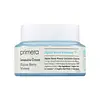What's inside
What's inside
 Key Ingredients
Key Ingredients

No key ingredients
 Benefits
Benefits

 Concerns
Concerns

 Ingredients Side-by-side
Ingredients Side-by-side

Water
Skin ConditioningGlycerin
HumectantButylene Glycol
HumectantSqualane
EmollientBis-Hydroxyethoxypropyl Dimethicone
EmollientCaprylic/Capric/Myristic/Stearic Triglyceride
EmollientSucrose Polystearate
EmollientDicaprylyl Ether
EmollientUrea
BufferingMethyl Trimethicone
Skin ConditioningPentaerythrityl Tetraethylhexanoate
EmollientGlyceryl Stearate
EmollientTheobroma Cacao Seed Butter
EmollientPolyglyceryl-3 Methylglucose Distearate
EmulsifyingStearic Acid
CleansingPalmitic Acid
EmollientHydrogenated Polyisobutene
EmollientGlyceryl Undecylenate
EmollientHydroxyethyl Acrylate/Sodium Acryloyldimethyl Taurate Copolymer
Emulsion StabilisingCetearyl Alcohol
EmollientArtemisia Princeps Leaf Water
MaskingParfum
MaskingXanthan Gum
EmulsifyingAcrylates/C10-30 Alkyl Acrylate Crosspolymer
Emulsion StabilisingGlyceryl Caprylate
EmollientTromethamine
BufferingEthylhexylglycerin
Skin ConditioningSorbitan Isostearate
EmulsifyingDisodium EDTA
Rubus Fruticosus Fruit Extract
AstringentArachidic Acid
CleansingMyristic Acid
Cleansing1,2-Hexanediol
Skin ConditioningTocopherol
AntioxidantFragaria Vesca Leaf Extract
AstringentGlycine Soja Oil
EmollientWater, Glycerin, Butylene Glycol, Squalane, Bis-Hydroxyethoxypropyl Dimethicone, Caprylic/Capric/Myristic/Stearic Triglyceride, Sucrose Polystearate, Dicaprylyl Ether, Urea, Methyl Trimethicone, Pentaerythrityl Tetraethylhexanoate, Glyceryl Stearate, Theobroma Cacao Seed Butter, Polyglyceryl-3 Methylglucose Distearate, Stearic Acid, Palmitic Acid, Hydrogenated Polyisobutene, Glyceryl Undecylenate, Hydroxyethyl Acrylate/Sodium Acryloyldimethyl Taurate Copolymer, Cetearyl Alcohol, Artemisia Princeps Leaf Water, Parfum, Xanthan Gum, Acrylates/C10-30 Alkyl Acrylate Crosspolymer, Glyceryl Caprylate, Tromethamine, Ethylhexylglycerin, Sorbitan Isostearate, Disodium EDTA, Rubus Fruticosus Fruit Extract, Arachidic Acid, Myristic Acid, 1,2-Hexanediol, Tocopherol, Fragaria Vesca Leaf Extract, Glycine Soja Oil
Water
Skin ConditioningButylene Glycol
HumectantDiglycerin
HumectantGlycerin
HumectantPentylene Glycol
Skin ConditioningTrehalose
HumectantAlanine
MaskingArginine
MaskingGlycine
BufferingSerine
MaskingGlycolipids
Skin ConditioningThreonine
Chamomilla Recutita Flower Extract
MaskingHydrolyzed Sodium Hyaluronate
Skin ConditioningCryptomeria Japonica Bud Extract
Skin ConditioningMalus Domestica Fruit Cell Culture Extract
Skin ConditioningGlycosyl Trehalose
Emulsion StabilisingCitric Acid
BufferingXanthan Gum
EmulsifyingSodium Citrate
BufferingC12-20 Alkyl Glucoside
EmulsifyingSodium Surfactin
CleansingHydrogenated Starch Hydrolysate
HumectantLecithin
EmollientPhenoxyethanol
PreservativeParfum
MaskingLinalool
PerfumingWater, Butylene Glycol, Diglycerin, Glycerin, Pentylene Glycol, Trehalose, Alanine, Arginine, Glycine, Serine, Glycolipids, Threonine, Chamomilla Recutita Flower Extract, Hydrolyzed Sodium Hyaluronate, Cryptomeria Japonica Bud Extract, Malus Domestica Fruit Cell Culture Extract, Glycosyl Trehalose, Citric Acid, Xanthan Gum, Sodium Citrate, C12-20 Alkyl Glucoside, Sodium Surfactin, Hydrogenated Starch Hydrolysate, Lecithin, Phenoxyethanol, Parfum, Linalool
Ingredients Explained
These ingredients are found in both products.
Ingredients higher up in an ingredient list are typically present in a larger amount.
Butylene Glycol (or BG) is used within cosmetic products for a few different reasons:
Overall, Butylene Glycol is a safe and well-rounded ingredient that works well with other ingredients.
Though this ingredient works well with most skin types, some people with sensitive skin may experience a reaction such as allergic rashes, closed comedones, or itchiness.
Learn more about Butylene GlycolGlycerin is already naturally found in your skin. It helps moisturize and protect your skin.
A study from 2016 found glycerin to be more effective as a humectant than AHAs and hyaluronic acid.
As a humectant, it helps the skin stay hydrated by pulling moisture to your skin. The low molecular weight of glycerin allows it to pull moisture into the deeper layers of your skin.
Hydrated skin improves your skin barrier; Your skin barrier helps protect against irritants and bacteria.
Glycerin has also been found to have antimicrobial and antiviral properties. Due to these properties, glycerin is often used in wound and burn treatments.
In cosmetics, glycerin is usually derived from plants such as soybean or palm. However, it can also be sourced from animals, such as tallow or animal fat.
This ingredient is organic, colorless, odorless, and non-toxic.
Glycerin is the name for this ingredient in American English. British English uses Glycerol/Glycerine.
Learn more about GlycerinParfum is a catch-all term for an ingredient or more that is used to give a scent to products.
Also called "fragrance", this ingredient can be a blend of hundreds of chemicals or plant oils. This means every product with "fragrance" or "parfum" in the ingredients list is a different mixture.
For instance, Habanolide is a proprietary trade name for a specific aroma chemical. When used as a fragrance ingredient in cosmetics, most aroma chemicals fall under the broad labeling category of “FRAGRANCE” or “PARFUM” according to EU and US regulations.
The term 'parfum' or 'fragrance' is not regulated in many countries. In many cases, it is up to the brand to define this term.
For instance, many brands choose to label themselves as "fragrance-free" because they are not using synthetic fragrances. However, their products may still contain ingredients such as essential oils that are considered a fragrance by INCI standards.
One example is Calendula flower extract. Calendula is an essential oil that still imparts a scent or 'fragrance'.
Depending on the blend, the ingredients in the mixture can cause allergies and sensitivities on the skin. Some ingredients that are known EU allergens include linalool and citronellol.
Parfum can also be used to mask or cover an unpleasant scent.
The bottom line is: not all fragrances/parfum/ingredients are created equally. If you are worried about fragrances, we recommend taking a closer look at an ingredient. And of course, we always recommend speaking with a professional.
Learn more about ParfumWater. It's the most common cosmetic ingredient of all. You'll usually see it at the top of ingredient lists, meaning that it makes up the largest part of the product.
So why is it so popular? Water most often acts as a solvent - this means that it helps dissolve other ingredients into the formulation.
You'll also recognize water as that liquid we all need to stay alive. If you see this, drink a glass of water. Stay hydrated!
Learn more about WaterXanthan gum is used as a stabilizer and thickener within cosmetic products. It helps give products a sticky, thick feeling - preventing them from being too runny.
On the technical side of things, xanthan gum is a polysaccharide - a combination consisting of multiple sugar molecules bonded together.
Xanthan gum is a pretty common and great ingredient. It is a natural, non-toxic, non-irritating ingredient that is also commonly used in food products.
Learn more about Xanthan Gum